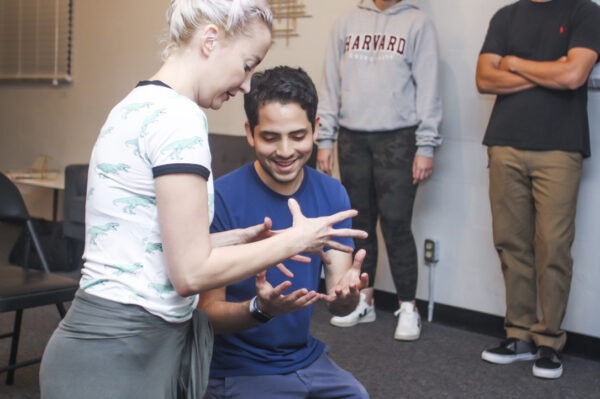
Where are We?
The second question in our formula of improv is where are we? This not only establishes the location of our scene, but also includes any props or other objects that our characters might be using. The only things we have on stage for our shows are chairs, everything else is imaginary. Because of this, we have to use our fundamental improv skills to ensure our scene partners and audience understand what we’re up to.
Location
Where does our scene take place? Since we’re playing pretend, our scenes could be anywhere—in a car, on the moon, falling through a black hole (I was in this scene once, it was great). The key is that we communicate clearly where we are either with dialog or with space work (our improv term for pantomime), and accept that the things we put in the scene are real. Establishing the location early on gives us the freedom to explore the world as the scene progresses. If we know we’re in an office because the scene is initiated with a line of dialog that communicates a work relationship, we may discover that the file cabinet is open for some reason, or the papers on the desk are very suspicious. We can use this discovery to move through the beats (the funny bits) of our scene. The location may also help us learn about our characters—what type of car or truck we’re in may indicate some social status, if we’re hurtling through space our characters are likely to be in distress. The location not only helps the scene feel real, it gives us a significant amount of information about the world, the characters, and ultimately, the game.
Objects
Every object we use in a scene is mimed. We never use our own phones, or wallets, or glasses, or underwear in our scenes. This gives us the freedom of not having to rely on actually having an object in order to use it, and makes it so that if the scene dictates that we have to be destructive, we’re not actually damaging our troupe-mates’ property. We can create anything we need in order to move the scene along or develop our characters. However, the objects should come from somewhere and go somewhere. We shouldn’t sleight-of-hand a glass from thin air and then just release it into the ether; that glass should be picked up from a table next to the chair, and placed down on the mantelpiece, for example. The more real we treat our objects, the more real they will seem to the audience, and by extension, the more immersed they’ll be in our performance.
Object and Space work is difficult. Our brains have a much harder time using imaginary objects while talking and thinking than they do real objects. When we first begin training, it is easy to find ourselves standing in the middle of the stage talking to our scene partner with our hands by our side and no real sense of the world our characters are inhabiting. As we grow as improvisers, our brains adjust to the miming and we find that the world opens up to us, our scenes actually get easier, and our playfulness increases. What a wonderful world to be in!
